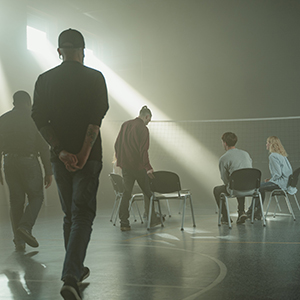Attachment insecurity predicts outcomes in an ACT-CBT group therapy for adults in a physical rehabilitation centre

Accepted: August 23, 2022
Appendix: 130
HTML: 34
All claims expressed in this article are solely those of the authors and do not necessarily represent those of their affiliated organizations, or those of the publisher, the editors and the reviewers. Any product that may be evaluated in this article or claim that may be made by its manufacturer is not guaranteed or endorsed by the publisher.
Authors
Adapting to chronic illness or disability is accompanied by acute and ongoing illness stressors. Psychological factors such as emotional distress and low self-efficacy are common experiences in chronic illness and disability and interfere with adaptation and psychosocial outcomes such as health-related quality of life. Transdiagnostic group psychotherapy may provide a parsimonious approach to psychological treatment in rehabilitation care by targeting shared illness stressors across mixed chronic illnesses and disabilities, and shared processes that maintain psychological symptoms. Attachment theory may explain individual differences in outcomes and help identify individuals at risk of poor health-related quality of life trajectories. Adults (N=109) participated in an 8-week process-based ACT-CBT psychotherapy group at a tertiary care physical rehabilitation centre between 2016 and 2020. Participants completed measures of emotional distress, self-efficacy, health-related quality of life, and attachment at pre- and post-treatment. Multilevel analyses indicated that patients improved on most outcomes at post-treatment. Attachment anxiety at pre-treatment was associated with more positive outcomes. Reliable change indices suggest clinically meaningful change for the majority of participants, but most were not recovered. Results provide proof-of-concept for the transdiagnostic group intervention and suggest that a longer course of treatment may be clinically indicated. Results warrant replication with larger and more diverse samples, and more robust designs.
How to Cite

This work is licensed under a Creative Commons Attribution-NonCommercial 4.0 International License.
PAGEPress has chosen to apply the Creative Commons Attribution NonCommercial 4.0 International License (CC BY-NC 4.0) to all manuscripts to be published.
Similar Articles
- Jan Roubal, Roman Hytych, Michal Čevelíček, Tomáš Řiháček, Personal therapeutic approach in Gestalt therapists working with clients suffering from medically unexplained psychosomatic symptoms , Research in Psychotherapy: Psychopathology, Process and Outcome: Vol. 24 No. 3 (2021)
- Joào F. Barreto, Paula Mena Matos, Balancing clinical risk with countertransference management protects alliance , Research in Psychotherapy: Psychopathology, Process and Outcome: Vol. 20 No. 3 (2017)
- Nina Jakhelln Laugen, Torun Grøtte, Truls Ryum, Patrick A. Vogel, Heidi Brattland, Katrine Høyer Holgersen, Something has sort of opened up for me: psychology students’ reflections after participating in an apprenticeship training model , Research in Psychotherapy: Psychopathology, Process and Outcome: Vol. 27 No. 2 (2024)
- Salvatore Gullo, Gianluca Lo Coco, Laura Salerno, Federica La Pietra, Vincenzo Bruno, A study of personality subtypes in treatment seeking obese patients , Research in Psychotherapy: Psychopathology, Process and Outcome: Vol. 16 No. 2 (2013)
- Marta Vecchiato, Chiara Sacchi, Alessandra Simonelli, Nicola Purgato, Evaluating the efficacy of psychodynamic treatment on a single case of autism. A qualitative research , Research in Psychotherapy: Psychopathology, Process and Outcome: Vol. 19 No. 1 (2016): Special issue on Qualitative and Quantitative Research in Child and Adolescent Psychotherapy: part 2
- Annalisa Tanzilli, Antonello Colli, Laura Muzi, Vittorio Lingiardi, Clinician Emotional Response Toward Narcissistic Patients: A Preliminary Report , Research in Psychotherapy: Psychopathology, Process and Outcome: Vol. 18 No. 1 (2015)
- Paola Manfredi, Claudia Taglietti, A psychodynamic contribution to the understanding of anger - The importance of diagnosis before treatment , Research in Psychotherapy: Psychopathology, Process and Outcome: Vol. 25 No. 2 (2022)
- Khalid K. Abdul-Razzak, Mohammad J. Alkhatatbeh, Nightmares and bad dreams among individuals with musculoskeletal pain: a link to vitamin D and calcium , Research in Psychotherapy: Psychopathology, Process and Outcome: Vol. 24 No. 2 (2021): SPECIAL ISSUE "Working on dreams, from psychotherapy to neuroscience"
- Giovanna Esposito, Francesco Cuomo, Angela Di Maro, Raffaella Passeggia, The assessment of therapist responsiveness in psychotherapy research: a systematic review , Research in Psychotherapy: Psychopathology, Process and Outcome: Vol. 27 No. 2 (2024)
- Vera Békés, Claire J. Starrs, J. Christopher Perry, Tracy A. Prout, Ciro Conversano, Mariagrazia Di Giuseppe, Defense mechanisms are associated with mental health symptoms across six countries , Research in Psychotherapy: Psychopathology, Process and Outcome: Vol. 26 No. 3 (2023)
<< < 5 6 7 8 9 10 11 12 13 14 > >>
You may also start an advanced similarity search for this article.

 https://doi.org/10.4081/ripppo.2022.634
https://doi.org/10.4081/ripppo.2022.634




